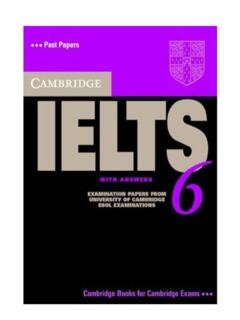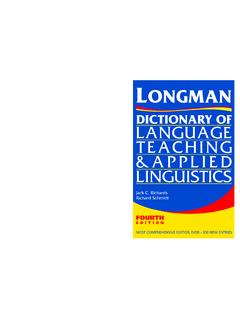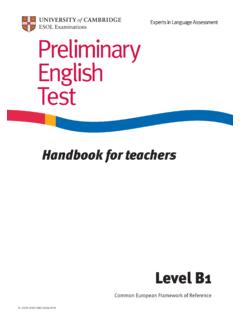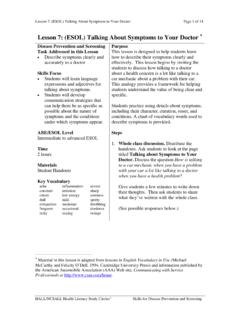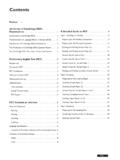Transcription of Cambridge IELTS 6 - Saint David
1 Cambridge IELTS 6 Examination papers from university of Cambridge ESOL Examinations: English for Speakers of Other Languages ~ Cambridge ~ UNIVERSI TY PRESS Cambridge university PRESS Cambridge . New York. Melbourne, Madrid, Cape Town, Singapore, Sao Paulo Cambridge university Press The Edinburgh Building, Cambridge CB2 8RU. UK Information o n this title: Cambridge university Press 2007 It is normally necessary for written permission for copying to be obta ined in advance from a publisher. The candidate a nswer sheets at the back of this book are designed to be copied and distributed in class. The no rmal requirements are waived here and it is not necessary to write to Cambridge university Press for permission for an individual teacher to make copies tor usc within ltis or her own classroom. Only those pages which carry the wording' UCLES 2007 ' may be copied.
2 First published 2007 ]>rinted in the United Kingdom at the university Press, Cambridge A catalogue record for this publication is m ailab/efrom the British Libmry ISBN 978 0 521 693073 Sl1tdent's Book with answers ISBN 978-0-521 693097 Cassette Set ISBN 978-0-521-693103 Audio CD Set ISBN 978-0-521-693080 Self-study f>ack Contents Introduction 4 Test I 10 Test 2 33 Test 3 55 Test 4 78 General Tra ining: Readin g and Writing Test A I 0 I General Tra ining: Reading and Writing Test B 114 Tapescripts 127 Answer key 151 Model a nd sample a nswers for Writing tasks 161 Sample answer sheets 173 Acknowledgements 176 Test 1 LISTE:\1!\G SECTION 1 Questions 1- 10 Questions 1-4 Complete the notes below. Write NO MOR E THAN THREE WORDS for each ans we1: 10 Notes on sports club Example Answer Name o f club: !'$~\ !.':e!~ Facilities available: Golf 1.
3 2 .. Classes available: Kick-boxing 3 .. Add itional facility: 4 .. (restaurant opening soon) Listening Questio11s 5-8 Complete rile table below. Wrire NO MORE THAN TWO NUMBERS (or each mswel: MEMBERSHIP SCHEMES Type Use of Cost of Times J oining Annual facilities classes fee subscription fee GOLD All Free Any time 250 5 .. SILVER All 6 .. from 7 .. to .. 225 300 BRONZE Restricted 3 to 50 8 .. weekdays only Questio11s 9 alld 10 Complete tile sentences below. Write ONE WORD ONLY for each cmsn e1: 9 To join th e centre, you need to book an instructor's .. 10 To book a tria l session, speak to David .. (0458 95311 ). I I Test/ SECTION 2 Questions 11- 20 Questions 11- 16 What cha nge has been made to each part of the theatre? Choose SIX cmsll'ersfrom the box and ll'ri!e the correctletfel; A- G, nexf 10 ques!ions 11- 16. RIVENDEN CITY THEATRE A doubled in number B given separate entrance c reduced in number D increased in size E replaced F stre ngthened G temporarily closed Part of the theatre 11 box office 12 shop 13 ordinary seats 14 seats for wheelchair users 15 lifts 16 dressing rooms t2 Listening Questio11s 17- 20 Complete the table below.)
4 Write NO MORE THAN TWO WORDS AND/OR A NUMBER .for each lii1S1re1: Play Dates Starting time Tickets available Price Royal Hunt October 13th to 18 .. pm for 19 .. 20 of t!te Sun 17 .. and .. 13 Test I SECTION 3 Questio11s 21-30 Questio11 21 Choose the correct lelfe1; A, B or C 21 What is Brian going to do before the course starts? A attend a class B write a report C read a book Questio11s 22- 25 Complete the table below. Write N O MORE THAN TWO WORDS for each ansll'el: College Facility Information Refectory inform them 22 .. about special dietary requirements 23 .. long waiting list, apply now Careers advice drop-in centre for information Fitness centre reduced 24 .. for students Library includes books, j ournals, equipment room containing audio-visual mate rials Computers ask your 25 .. to arrange a password with the technical support team 14 Listening Questio11s 26- 30 Complete the summmy below.
5 Write NO MORE TH A N TWO each answer. Business Centre The Business Resource Centre contains materials such as books and manuals to be used for training. It is possible to hire 26 .. and 27 .. There are materials for working o n study skills ( 2S .. ) and other subjects inc lude flnance and 29 .. 30 .. membership costs 50 per year. 15 Test I SECTION 4 Questio11s 31- 40 Questio11s 31- 37 Complete the table be/ott: Write N O MOR E THAN T WO WORDS for each ans1re1: S ocial history of t he East End of London P eriod Situation I st- 4th centuries Produce from the area was used to 3 .. the people of London. 5th- 10th centuries New technology allowed the production of good s made of 32 .. and .. II th century Lack of 33 .. in the East End encouraged the growth o f businesses. 16th century Construction of facilities for the building o f 34.
6 Stimulated international trade. Agricultural workers came from other parts o f 35 .. to look for work. 17th century Marshes were drained to provide land that could be 36 .. on. 19th century Inhabitants lived in conditions of great 37 .. with very poor sanitation. 16 Reading Questions 38-40 Choose THREE leuers, A-G Which THREE of the following problems are mentioned in connection with 20th century housing in the East End? A unsympathetic landlords B unclean water c heating problems D h igh rents E overcrowding F poor standards of building G houses catching fire 17 Test/ READII\G READING PASSAGE 1 You should spend about 20 minutes on Questions 1-13, which are based on Reading Passage I below. AUSTRALIA'S SPORTING SUCCESS A They play hard. they play often, and t hey play to win. Australian sports teams win more than their fair share of titles, demolishing rivals with seeming ease.
7 How do they do it? A big part of the secret is an extensive and expensive network of sporting academies under pinned by science and medicine. At the Australian Institute of Sport (AIS), hundreds of youngsters and pros live and train under the eyes of coaches. Another body, the Australian Sports Commission (ASC), finances programmes of excellence in a total of 96 sports for thousands of sportsmen and women. B oth provide intensive coaching. training facilit ies and nutrit ional advice. B Inside the academies, science takes centre stage. The AIS employs more than I 00 sports scientists and doctors, and collaborates with scores oi others in universities and research centres. AIS scientists work across a number of sports. applying skills learned in one -such as building muscle strength in golfers-to others. such as swimming and squash. They are backed up by technicians who design instruments to collect cata from athletes.
8 They all focus on one aim: winning. 'We can't waste our time looking at ethereal scientific questions that don't help the coach work with an athlete and improve performance; says Peter Fricker. chief of science at AIS. C A lot of their work comes down to measurement - everything from the exact angle of a swimmer's dive to the second-by-second power output of a cyclist. This data is used to wring improvements out of athletes. The focus is on individLals, tweaking performances to squeeze an extra hundredth of a second here, an extra millimetre there. No gain is too slight to bother with. It's the t int. gradual i mprovements that add up to world-beating results. To demonstrate how the system works, Bruce Mason at AIS shows off the prototype of a 30 analysis tool fer studying swimmers. A wire-frame model of a champion swimmer slices through the water, her anms moving in slow motion.
9 Looking side-on, Mason measures the distance between strokes. From above, he analyses how her spine swivels. When fully developed, t his system will enable him to build a biomechanical profile for coaches to use to help budding swimmers. Mason's contribution to sport also includes the development of the SWAN (SWimming AN alysis) system now used in Australian national competitions. It collects images from digital cameras 18 Reading running at 50 frames a second and breaks down each part of a swimmer's performance into factors that can be analysed individually - stroke length, stroke frequency. average duration of each stroke, velocity. start lap and finish times, and so on. At the end of each race, SWAN spits out data on each swimmer. D 'Take a look,' says Mason, pulling out a sheet of data. He point s out the dat a on the swimmers in second and third place.
10 Which shows that the one who fin ished third actually swam faster. So why did he finish 35 hundredths of a second down? 'His turn times were 44 hundredths of a second behind the other guy,' says Mason. 'If he can improve on his turns, he can do much better.' Th is is the kind of accuracy that AI$ scientists' research is bringing t o a range of sports. With the Cooperative Research Centre for Micro Technology in Melbourne, they are developing unobtrusive sensors that will be embedded in an athlete's clothes or running shoes to monitor heart rate, sweating, heat production or any other factor that might have an impact on an athlete's ability to run. There's more to it than simply measuring performance. Fricker gives the example of athletes who may be down with coughs and colds I I or 12 t imes a year: After years of experimentation, AI$ and the university of Newcastle in New South Wales developed a t est that measures how much of the immune-system prot ein immunoglobulin A is present in athletes' saliva.
